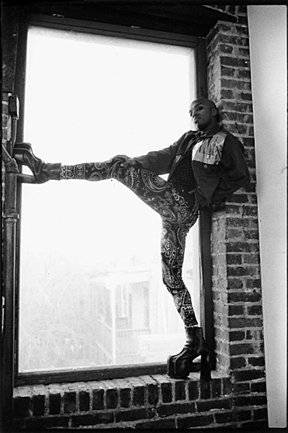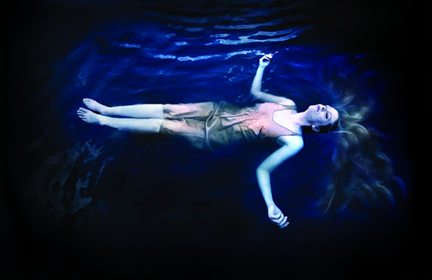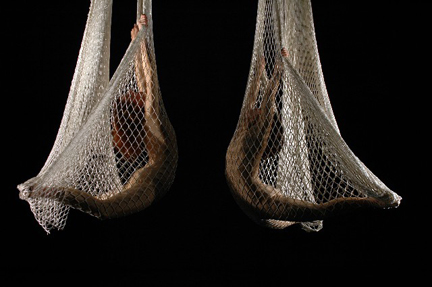Capital Fringe
Critic’s Notebook
Earth, Wind, and Fire: Elements of the Capital Fringe Festival
Washington, DC,
July 20-30, 2006
by Christopher Correa
copyright ©2006 by Christopher Correa
What else can be said about these dog days of summer? To paraphrase Cole Porter, it’s just too darn hot. Audiences hoping to chill out a bit over the last week — one of the hottest on record — found happy refuge in the Capital Fringe Festival, which featured ninety-seven total performed works. Some were splashy, others spritzy, and there were more than a couple cold fish out there — but for eleven days straight, Washington was a refreshing place to be.
This is not to say that what was on display along the many arteries stemming from Sixth Street happened to be particularly cool. A festival of this size, scope, and breadth, being the inaugural of its kind in DC, couldn’t help but exude the flushed air of a dancehall filled with dolled-up preteens who are nervous for their very first social.
The works varied in depth and in charm. Not one, but two, painters known for their surrealist fever dreams were given voice. One, “Frida Vice-Versa,” depicted a painting session given by Frida Kahlo, which served as an abject lesson on a life as an artist, or art as a lifestyle, or something to that effect. The other was “Desire Caught by the Tail: A Play by Pablo Picasso,” a rare example of the twentieth century’s most prolific Cubist, who set aside his brush and palette during World War II, to pen an antiwar screed drizzled with licentiousness and dappled with colorful poetry and choreography. Both works were well intentioned but flat as a pulled canvas.
 A fine example of a current artist who mixes his media with painterly fluidity was Monstah Black, whose one-man show, titled “Skipping Backwards,” was nothing if not vibrant. It presented a dazzling survey of emotion and motion that mined every crack, crag, and glimmer of its performer’s life, with the added whimsy of Madonna-laced anecdotes and a ripping good set of original songs written by and sung by the star. Black, costumed like an electric roller derby, hobbled around cautiously on platform heels tall enough to increase the city’s height restrictions. He slowly stabbed his legs at the floor, making his way along the stage, and — defying his seemingly demented footwear — erupted in a fit of spread arms and leg swirls that set pulses, ours and probably his, racing.
A fine example of a current artist who mixes his media with painterly fluidity was Monstah Black, whose one-man show, titled “Skipping Backwards,” was nothing if not vibrant. It presented a dazzling survey of emotion and motion that mined every crack, crag, and glimmer of its performer’s life, with the added whimsy of Madonna-laced anecdotes and a ripping good set of original songs written by and sung by the star. Black, costumed like an electric roller derby, hobbled around cautiously on platform heels tall enough to increase the city’s height restrictions. He slowly stabbed his legs at the floor, making his way along the stage, and — defying his seemingly demented footwear — erupted in a fit of spread arms and leg swirls that set pulses, ours and probably his, racing.
“Skipping Backwards” provided the West Virginia-raised New Yorker with a podium from which he pontificated about racism and sexual bigotry with tangy resentment. We’ve heard all this before, though, and the final act’s music video, a sermon chastising a small-minded man who criticized Black on the street, boasted dramatic impact along the lines of the very dated “RENT” on Broadway. It was little more than a graffito that overlayed the surface of Black’s graciousness and theatricality. His spidery dance, during which he batted around a glowstick, was as supple as choreography gets, and his body language, propped by an umbrella and a pair of denim capris, told a story of Somerset Maugham-esque slyness.
For many Fringe Festival attendees, the hot spot was Gwydion Suilebhan’s “Abstract Nude,” which was performed only once, at Flashpoint-Mead Theatre Lab. It delineated both the concept and the construct of art, from a gallery of perspectives. The performers who encountered the titular, titillating work demonstrated the affirmations, the frustrations, and the knottiness of being affected by a piece of art.
 What came across better on paper than in performance was another surprise hit, called “La Corbiere,” a leaden, demi-epic poem about prostitutes who drowned in a shipwreck off the Isle of Jersey during World War II. The work was given a great deal of publicity primarily because it had secured a plum venue: the Georgetown swimming pool. Labled as dance as well as drama by the theatre company Solas Nua, what it more closely resembled was pantomine, crossed with shouting. Innovation aside, what was most apparent was that the story of these dames at sea was coarsely articulated by Anne Le Marquand Hartigan, and watery in property.
What came across better on paper than in performance was another surprise hit, called “La Corbiere,” a leaden, demi-epic poem about prostitutes who drowned in a shipwreck off the Isle of Jersey during World War II. The work was given a great deal of publicity primarily because it had secured a plum venue: the Georgetown swimming pool. Labled as dance as well as drama by the theatre company Solas Nua, what it more closely resembled was pantomine, crossed with shouting. Innovation aside, what was most apparent was that the story of these dames at sea was coarsely articulated by Anne Le Marquand Hartigan, and watery in property.
Two male actors played both sailors and Nazi officers, to hammy results. Their job was to goose step hungrily, and toss off verbal concoctions like “Cunt/Slit/Slut” to the floating victims. Directors Michael Dove and Linda Murray provided their female contingent with the tough stuff. They bobbed their heads from under the water, dueling only with the moon’s own face that rippled against the currents. A few of them were given flotsam and jetsam to discharge like “Where are you?” “I can’t see you!” “Sea salt, sand sand.” The dance quotient was more interesting. Aside from the dunking and splashing around, some genuinely clever movements were integrated. Arm scoops and hieroglyph-like gesticulations filled the void and provided enough surprise and silken beauty to distract us from the light show that the electrical storm overhead supplied to command our attention.
 But the most significant piece I caught at the Fringe Festival was Arachne Aerial Arts company’s “Luxury Lofts Coming Soon!” The two dancers (Andrea Burkholder and Sharon Witting) performed the entirety of their performance well, aloft. Their apparatus were a pair of concentric circles hanging stage right, a trapeze swinging over the audience, and two drape-like nets. Burkholder and Witting threaded themselves through the figure eight and, in remarkable feats of control and grace, sat on the edge like they were lounging on rotating hammocks. A sign marking a real estate development was placed on the circles, and the dancers retreated to the wings, only to reappear, descending from above, onto the aforementioned trapeze. They clung to it as daintily as birds, and tumbled off of it, catching their grip to stop just before they crashed into the crowds a mere three feet below. The pair used one another’s legs as mock apparatus, slipping to the ends of limbs and linking elbows with feet. The designs of their figures cast elegant, angular shadows against the stage. Then, as mystically as they had appeared, the two ascended into the scaffolds, and in their place, a bouquet of pastel balloons trumpeted the opening of a high-rise complex.
But the most significant piece I caught at the Fringe Festival was Arachne Aerial Arts company’s “Luxury Lofts Coming Soon!” The two dancers (Andrea Burkholder and Sharon Witting) performed the entirety of their performance well, aloft. Their apparatus were a pair of concentric circles hanging stage right, a trapeze swinging over the audience, and two drape-like nets. Burkholder and Witting threaded themselves through the figure eight and, in remarkable feats of control and grace, sat on the edge like they were lounging on rotating hammocks. A sign marking a real estate development was placed on the circles, and the dancers retreated to the wings, only to reappear, descending from above, onto the aforementioned trapeze. They clung to it as daintily as birds, and tumbled off of it, catching their grip to stop just before they crashed into the crowds a mere three feet below. The pair used one another’s legs as mock apparatus, slipping to the ends of limbs and linking elbows with feet. The designs of their figures cast elegant, angular shadows against the stage. Then, as mystically as they had appeared, the two ascended into the scaffolds, and in their place, a bouquet of pastel balloons trumpeted the opening of a high-rise complex.
Finally, the dancers took to their nets and scaled them with arachnid delicacy. They tangled themselves in the stretchy webs, rolling their bodies upward, like human cigarettes. A couple of greedy real estate developers walked onstage and looked up, noticing the performers in their outstretched suspended animation. The developers smiled, left the stage, and Burkholder and Witting let go, unfurling like scrolls as their plummet stopped short of the floor. This last image, suggested the grid-like schematics of blueprints, blurred by the notion that the real estate market—always in flux—had spiked and fallen dramatically. “Luxury Lofts Coming Soon!” gave the Capital Fringe Festival a degree of sophistication and polish not often seen, and gave Washington, DC a sobering illustration of how expensive and dangerous it is to live in a city like ours. It was a hot little number, but a cold hard fact.
Volume 4, No. 30
August 7, 2006
copyright ©2006 Christopher Correa
www.danceviewtimes.com